Yield Response of Spring Maize under Future Climate and the Effects of Adaptation Measures in Northeast China
Abstract
:1. Introduction
2. Materials and Methods
2.1. Study Sites
2.2. DSSAT-CERES-Maize Crop Model
2.3. Criteria for Site Selection in Validating the Model
- Maize cultivars must have been cultivated for a minimum of 3 years and at the same time they should not have been stressed by either diseases, pests, insects or severe climatic events.
- Records must be available on good field management practices, e.g., adjusting sowing dates, row spacing, cultivar change and irrigation.
- The location of the study sites should be near the Agricultural Meteorological Experimental Stations (AMESs) to ensure easy accessibility to accurate weather observation data.
2.4. Climate Scenario and Climate Data
2.5. Crop Model Input Data
2.6. Genetic Coefficients
2.7. Model Calibration and Validation
Method to Manage the Uncertainty of Simulations
3. Results
3.1. Changes in the Major Meteorological Elements by the 2030s and 2050s in Northeast China
3.2. Model Calibration and Validation
Genetic Parameters Estimation
3.3. Impact of Future Climate Change on Maize Yield by the 2030s and 2050s
3.3.1. Impact on the Time-to-Flowering
3.3.2. Impact on the Time-to-Maturity
3.3.3. Impact on Maize Yield
3.4. Effect of Adaptation Measures on Maize Yield Based on Different Model Parameters
3.4.1. Effect of Changing Planting Dates on Maize Yield
3.4.2. Effect of Adding Irrigation Practices on Maize Yield
3.4.3. Effect of Replacing Cultivar on Maize Yield
3.4.4. Effect of Adopting Multiple Measures on Maize Yield
4. Discussion
4.1. Possible Future Meteorological Elements in NEC
4.2. Impact of Future Climate Change on Maize Yield under Different Parameters
4.3. Effect of Adaptaion Measures on Maize Yield
5. Conclusions
Author Contributions
Funding
Institutional Review Board Statement
Informed Consent Statement
Data Availability Statement
Acknowledgments
Conflicts of Interest
References
- Lin, Y.; Wu, W.; Ge, Q. CERES-Maize model-based simulation of climate change impacts on maize yields and potential adaptive measures in Heilongjiang Province, China. J. Sci. Food Agric. 2015, 95, 2838–2849. [Google Scholar] [CrossRef] [PubMed]
- Lin, Y.; Feng, Z.; Wu, W.; Yang, Y.; Zhou, Y.; Xu, C. Potential impacts of climate change and adaptation on maize in Northeast China. Agron. J. 2017, 109, 1476–1490. [Google Scholar] [CrossRef] [Green Version]
- Kuo, W. Simulation of Potential Productivity and Cultivation Measures by CERES Maize Model Based on Climate Factors in N.E China. Master’s Thesis, Shandong Agricultural University, Taian, China, 2016. [Google Scholar]
- Ma, F.; Li, M.; Wei, N.; Dong, L.; Zhang, X.; Han, X.; Li, K.; Guo, L. Impacts of Elevated Atmospheric CO2 and N Fertilization on N2O Emissions and Dynamics of Associated Soil Labile C Components and Mineral N in a Maize Field in the North China Plain. Agronomy 2022, 12, 432. [Google Scholar] [CrossRef]
- Diao, T.; Peng, Z.; Niu, X.; Yang, R.; Ma, F.; Guo, L. Changes of soil microbes related with carbon and nitrogen cycling after long-term CO2 enrichment in a typical Chinese maize field. Sustainability 2020, 12, 1250. [Google Scholar] [CrossRef] [Green Version]
- Zhao, J.; Yang, X.; Liu, Z.; Lv, S.; Wang, J.; Dai, S. Variations in the potential climatic suitability distribution patterns and grain yields for spring maize in Northeast China under climate change. Clim. Chang. 2016, 137, 29–42. [Google Scholar] [CrossRef]
- Chen, X.; Chen, F.; Chen, Y.; Gao, Q.; Yang, X.; Yuan, L.; Zhang, F.; Mi, G. Modern maize hybrids in Northeast China exhibit increased yield potential and resource use efficiency despite adverse climate change. Glob. Chang. Biol. 2012, 19, 923–936. [Google Scholar] [CrossRef]
- Tan, J.; Yang, P.; Liu, Z.; Wu, W.; Zhang, L.; Li, Z.; You, L.; Tang, H.; Li, Z. Spatio-temporal dynamics of maize cropping system in Northeast China between 1980 and 2010 by using spatial production allocation model. J. Geogr. Sci. 2014, 24, 397–410. [Google Scholar] [CrossRef]
- Zhao, J.; Yang, X.; Lin, X.; Sassenrath, G.F.; Dai, S.; Lv, S.; Chen, X.; Chen, F.; Mi, G. Radiation interception and use efficiency contributes to higher yields of newer maize hybrids in Northeast China. Agron. J. 2015, 107, 1473–1480. [Google Scholar] [CrossRef]
- Tao, F.; Zhang, Z.; Liu, J.; Yokozawa, M. Modelling the impacts of weather and climate variability on crop productivity over a large area: A new super-ensemble-based probabilistic projection. Agric. For. Meteorol. 2009, 149, 1266–1278. [Google Scholar] [CrossRef]
- Mi, N.; Cai, F.; Zhang, S.; Zhang, Y.; Ji, R.; Chen, N.; Ji, Y.; Wang, D. Thermal time requirements for maize growth in Northeast China and their effects on yield and water supply under climate change conditions. Water 2021, 13, 2612. [Google Scholar] [CrossRef]
- Wang, M.; Li, Y.; Ye, W.; Bornman, J.F.; Yan, X. Effects of climate change on maize production, and potential adaptation measures: A case study in Jilin province, China. Clim. Res. 2011, 46, 223–242. [Google Scholar] [CrossRef] [Green Version]
- IPCC. (Intergovernmental Panel on Climate Change): Contribution of Working Group II to the Fourth Assessment Report of the Intergovernmental Panel on Climate Change. In Climate Change 2007: Impacts, Adaptation and Vulnerability; IPCC: Geneva, Switzerland, 2007. [Google Scholar]
- Tao, F.; Zhang, Z. Adaptation of maize production to climate change in North China Plain: Quantify the relative contributions of adaptation options. Eur. J. Agron. 2010, 33, 103–116. [Google Scholar] [CrossRef]
- Liu, Z.; Hubbard, K.G.; Lin, X.; Yang, X. Negative effects of climate warming on maize yield are reversed by the changing of sowing date and cultivar selection in Northeast China. Glob. Chang. Biol. 2013, 19, 3481–3492. [Google Scholar] [CrossRef] [PubMed]
- Xu, F.; Wang, B.; He, C.; Liu, D.L.; Feng, P.; Yao, N.; Zhang, R.; Xu, S.; Xue, J.; Feng, H.; et al. Optimizing sowing date and planting density can mitigate the impacts of future climate on maize yield: A case study in the Guanzhong plain of China. Agronomy 2021, 11, 1452. [Google Scholar] [CrossRef]
- Cuculeanu, V.; Marica, A.; Simota, C. Climate change impact on agricultural crops and adaptation options in Romania. Clim. Res. 1999, 12, 153–160. [Google Scholar] [CrossRef] [Green Version]
- Meng, E.C.H.; Hu, R.; Shi, X.; Zhang, S. Maize in China: Production Systems, Constraints, and Research Priorities; CIMMYT: México-Veracruz, Mexico, 2006. [Google Scholar]
- Tao, F.; Zhang, Z. Climate change, wheat productivity and water use in the North China Plain: A new super-ensemble-based probabilistic projection. Agric. For. Meteorol. 2013, 170, 146–165. [Google Scholar] [CrossRef]
- UNFCCC. Compendium on Methods and Tools to Evaluate Impacts of, and Vulnerability and Adaptation to, Climate Change UNFCCC (Issue February). 2008. Available online: https://unfccc.int/files/adaptation/nairobi_workprogramme/compendium_on_methods_tools/application/pdf/20080307_compendium_m_t_complete.pdf,2008.02 (accessed on 7 May 2022).
- Xiong, W.; Matthews, R.; Holman, I.; Lin, E.; Xu, Y. Modelling China’s potential maize production at regional scale under climate change. Clim. Change 2007, 85, 433–451. [Google Scholar] [CrossRef]
- Yin, Y.; Tang, Q.; Liu, X. A multi-model analysis of change in potential yield of major crops in China under climate change. Earth Syst. Dyn. 2015, 6, 45–59. [Google Scholar] [CrossRef] [Green Version]
- Sorech, E.; Kibebew, K.; Gebre, H. Climate Characterization and Modelling the Impacts (Issue March). Master’s Thesis, Haramaya University, Haramaya, Ethiopia, 2016. [Google Scholar]
- Angatrom, A. Solar and terrestrial radiation. Report to the international commission for solar research on actinometric investigations of solar and atmospheric radiation. Q. J. R. Meteorol. Soc. 1924, 50, 121–126. [Google Scholar] [CrossRef]
- Xia, J.; Ning, L.; Wang, Q.; Chen, J.; Wan, L.; Hong, S. Vulnerability of and risk to water resources in arid and semi-arid regions of West China under a scenario of climate change. Clim. Chang. 2017, 144, 549–563. [Google Scholar] [CrossRef]
- Ngwira, A.R.; Aune, J.B.; Thierfelder, C. DSSAT modelling of conservation agriculture maize response to climate change in Malawi. Soil Tillage Res. 2014, 143, 85–94. [Google Scholar] [CrossRef]
- Röll, G.; Memic, E.; Graeff-Hönninger, S. Implementation of an automatic time-series calibrationmethod for the DSSAT wheatmodels to enhance multi-model approaches. Agron. J. 2020, 112, 3891–3912. [Google Scholar] [CrossRef]
- Jia, H.C.; Pan, D.H.; Li, J.; Zhang, W.; Ghulam, R. Risk assessment of maize drought disaster in southwest China using the Environmental Policy Integrated Climate model. J. Mt. Sci. 2016, 13, 465–475. [Google Scholar] [CrossRef]
- Jones, J.W.; Hoogenboom, G.; Boote, K.J.; Poter, C.H. Influence of likelihood function choice for estimating crop model parameters using the generalized likelihood uncertainty estimation method. Agric. Syst. 2010, 103, 256–264. [Google Scholar] [CrossRef]
- Moreno-Cadena, L.P.; Hoogenboom, G.; Fisher, M.J.; Ramirez-Villegas, J.; Prager, S.D.; Becerra Lopez-Lavalle, L.A.; Pypers, P.; Mejia de Tafur, M.S.; Wallach, D.; Muñoz-Carpena, R.; et al. Importance of genetic parameters and uncertainty of MANIHOT, a new mechanistic cassava simulation model. Eur. J. Agron. 2020, 115, 126031. [Google Scholar] [CrossRef]
- Saltelli, A.; Ratto, M.; Andres, T.; Campolongo, F.; Cariboni, J.; Gatelli, D.; Saisana, M.; Tarantola, S. Global Sensitivity Analysis: The Primer; John Wiley & Sons, Ltd.: London, UK, 2008. [Google Scholar] [CrossRef] [Green Version]
- DeJonge, K.C.; Ascough, J.C.; Ahmadi, M.; Andales, A.A.; Arabi, M. Global sensitivity and uncertainty analysis of a dynamic agroecosystem model under different irrigation treatments. Ecol. Model. 2012, 231, 113–125. [Google Scholar] [CrossRef]
- Hao, X.; He, W.; Lam, S.K.; Li, P.; Zong, Y.; Zhang, D.; Li, F.Y. Enhancement of no-tillage, crop straw return and manure application on field organic matter content overweigh the adverse effects of climate change in the arid and semi-arid Northwest China. Agric. For. Meteorol. 2020, 295, 108199. [Google Scholar] [CrossRef]
- Li, K.; Xiong, W.; Pan, J.; Lin, E.; Li, Y.; Han, X. Evaluation of China’s corn yield trend under the background of future warming of 1.5 °C and 2.0 °C. China Agric. Meteorol. 2018, 39, 765–777. [Google Scholar]
- Zhao, J.; Yang, X. Spatial patterns of yield-based cropping suitability and its driving factors in the three main maize-growing regions in China. Int. J. Biometeorol. 2019, 63, 1659–1668. [Google Scholar] [CrossRef]
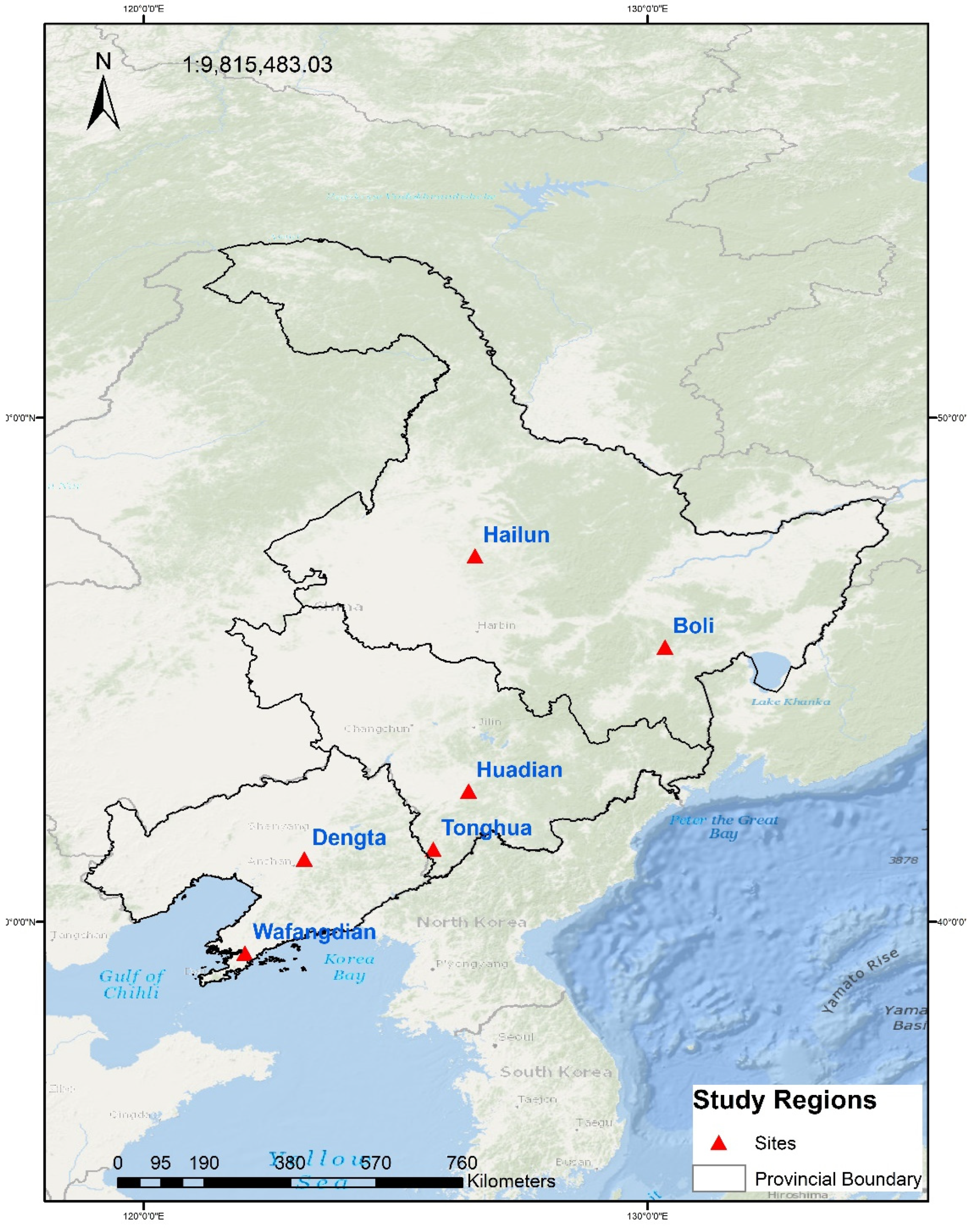
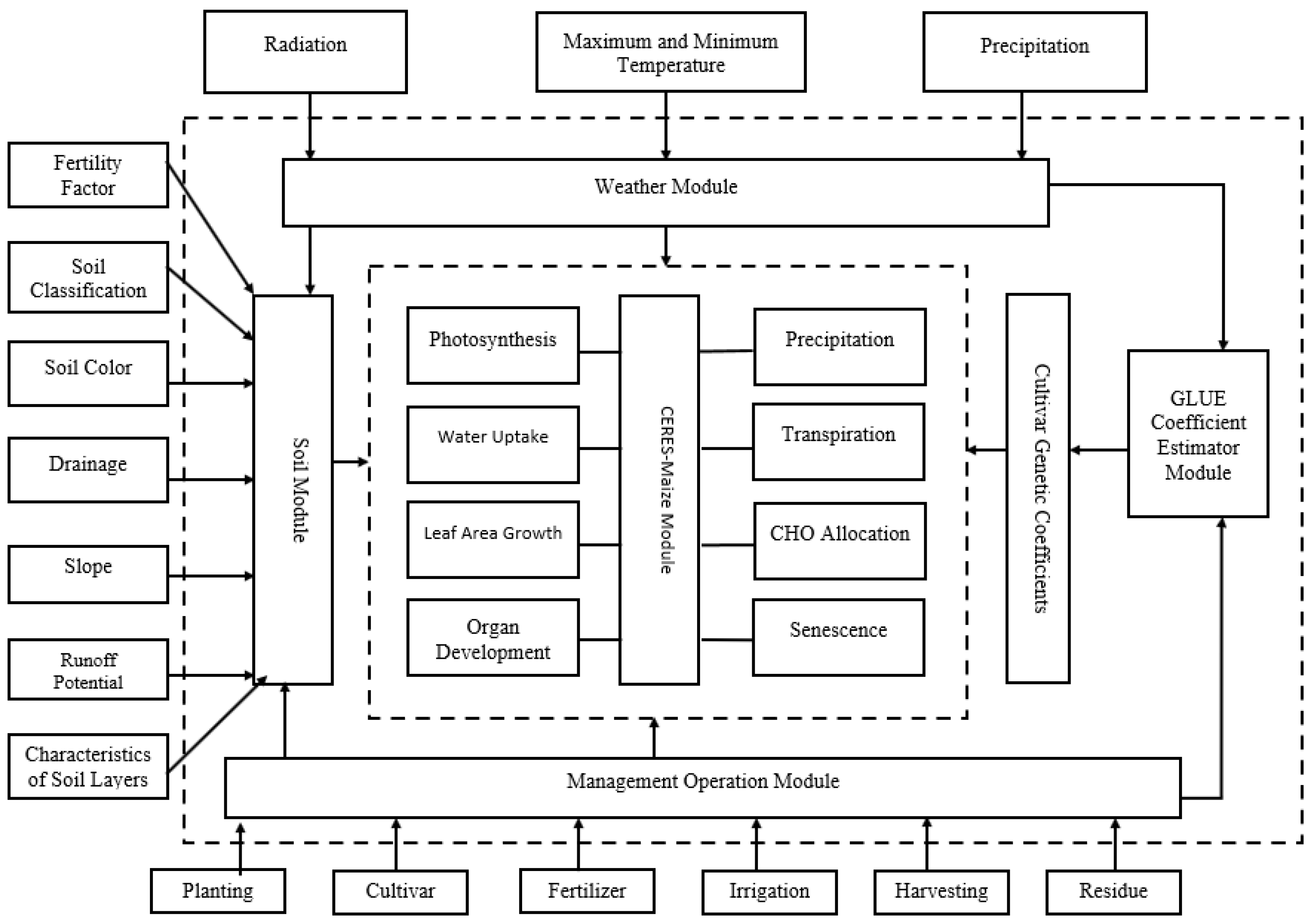

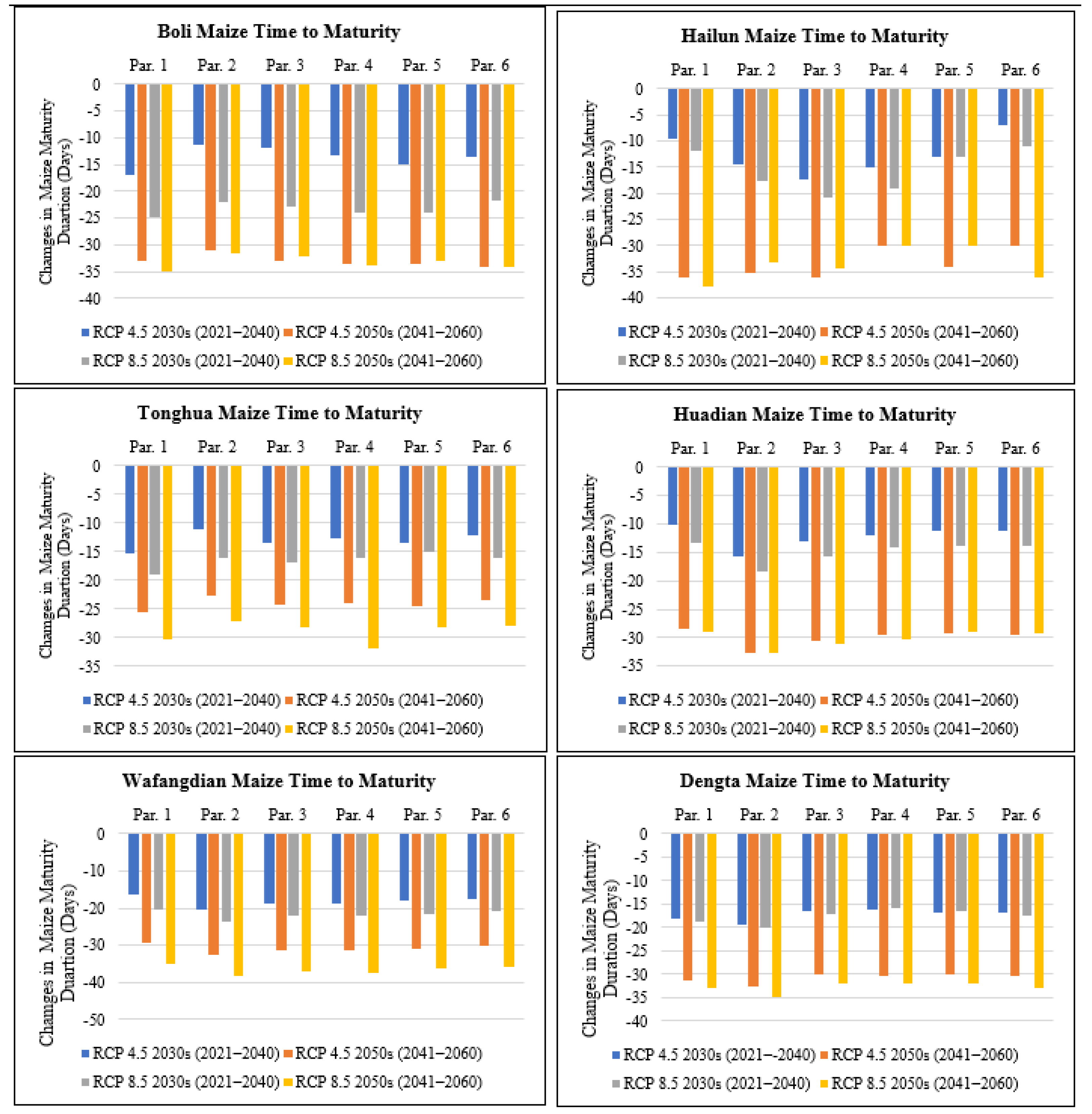
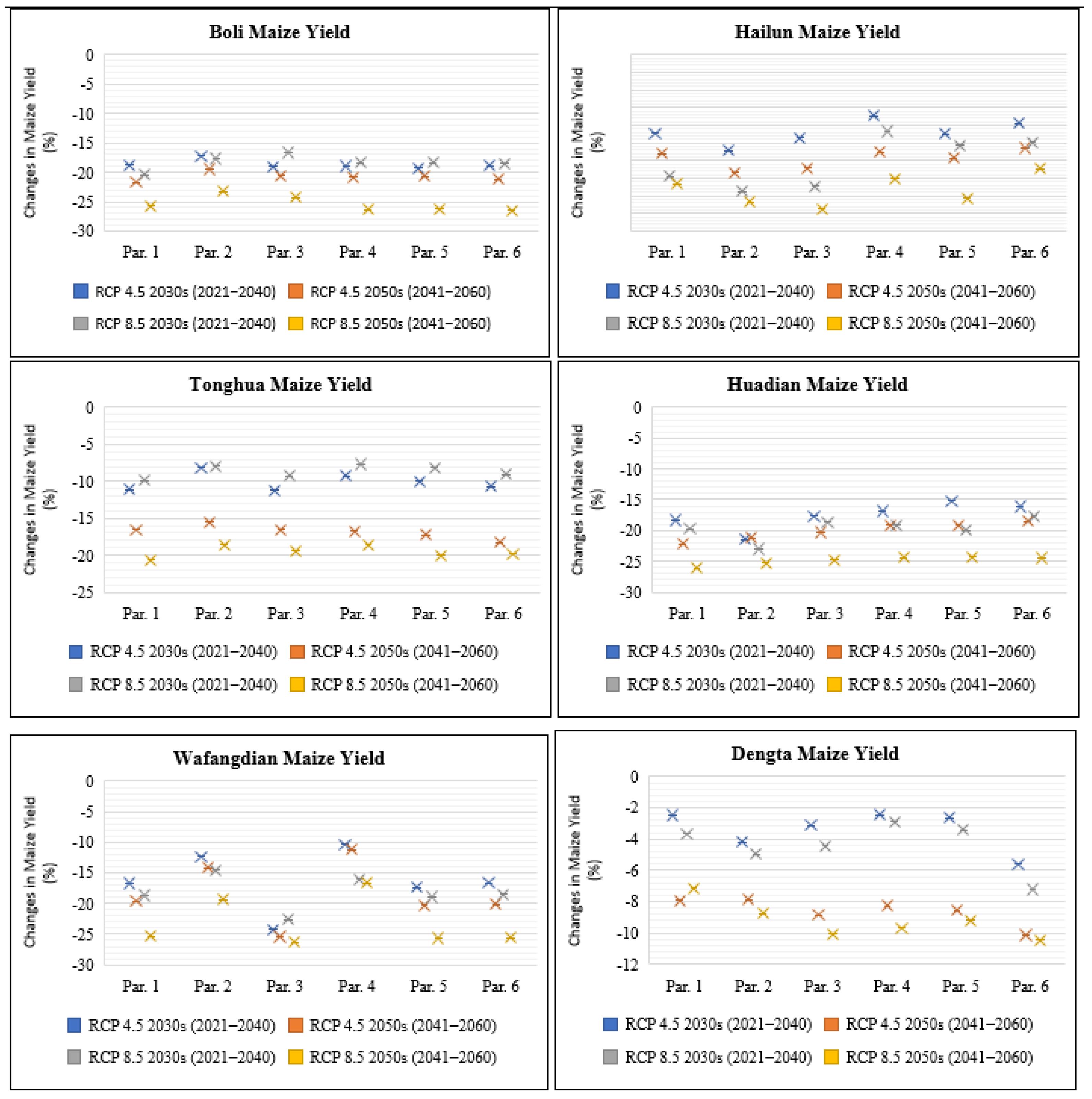
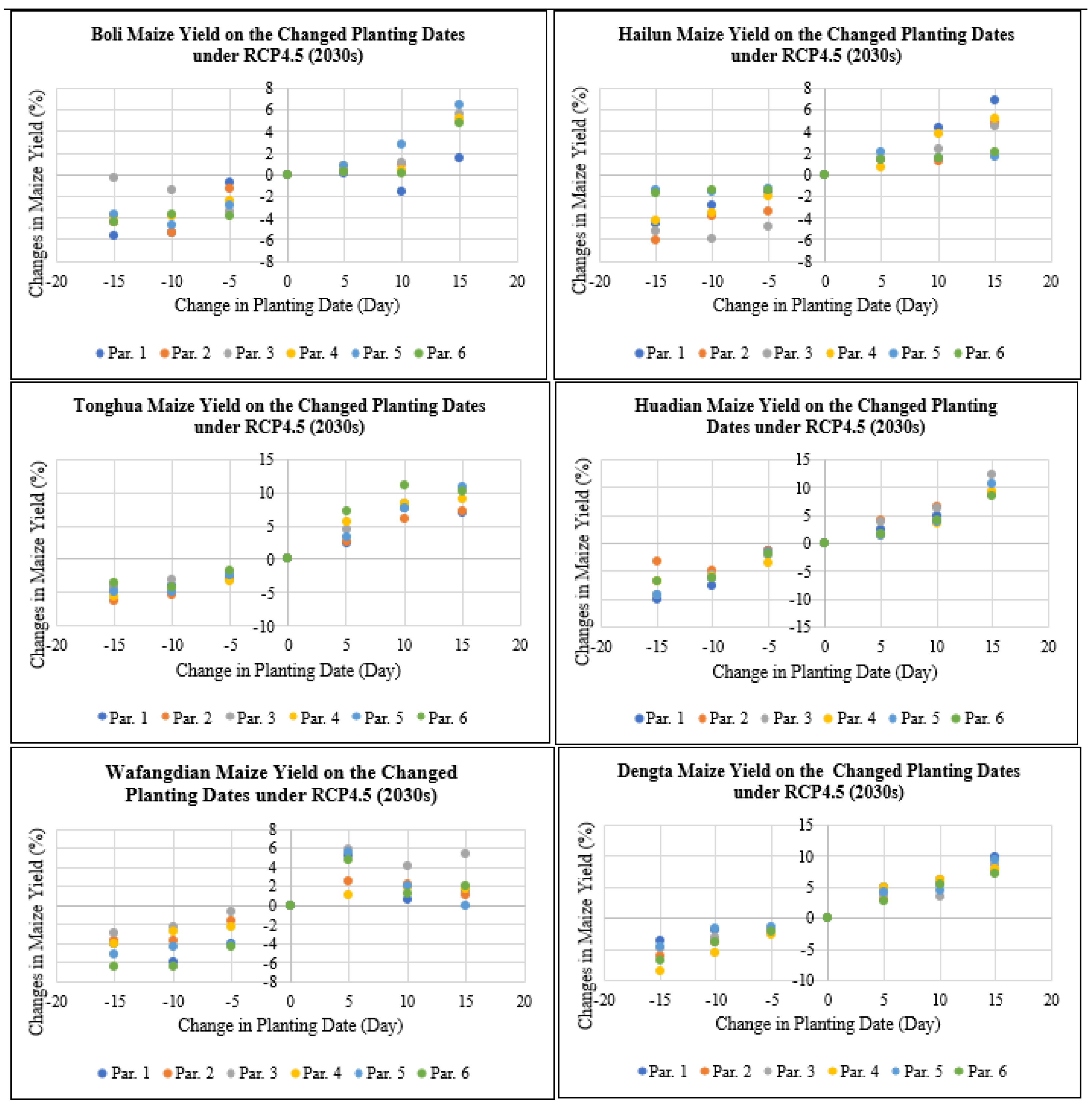
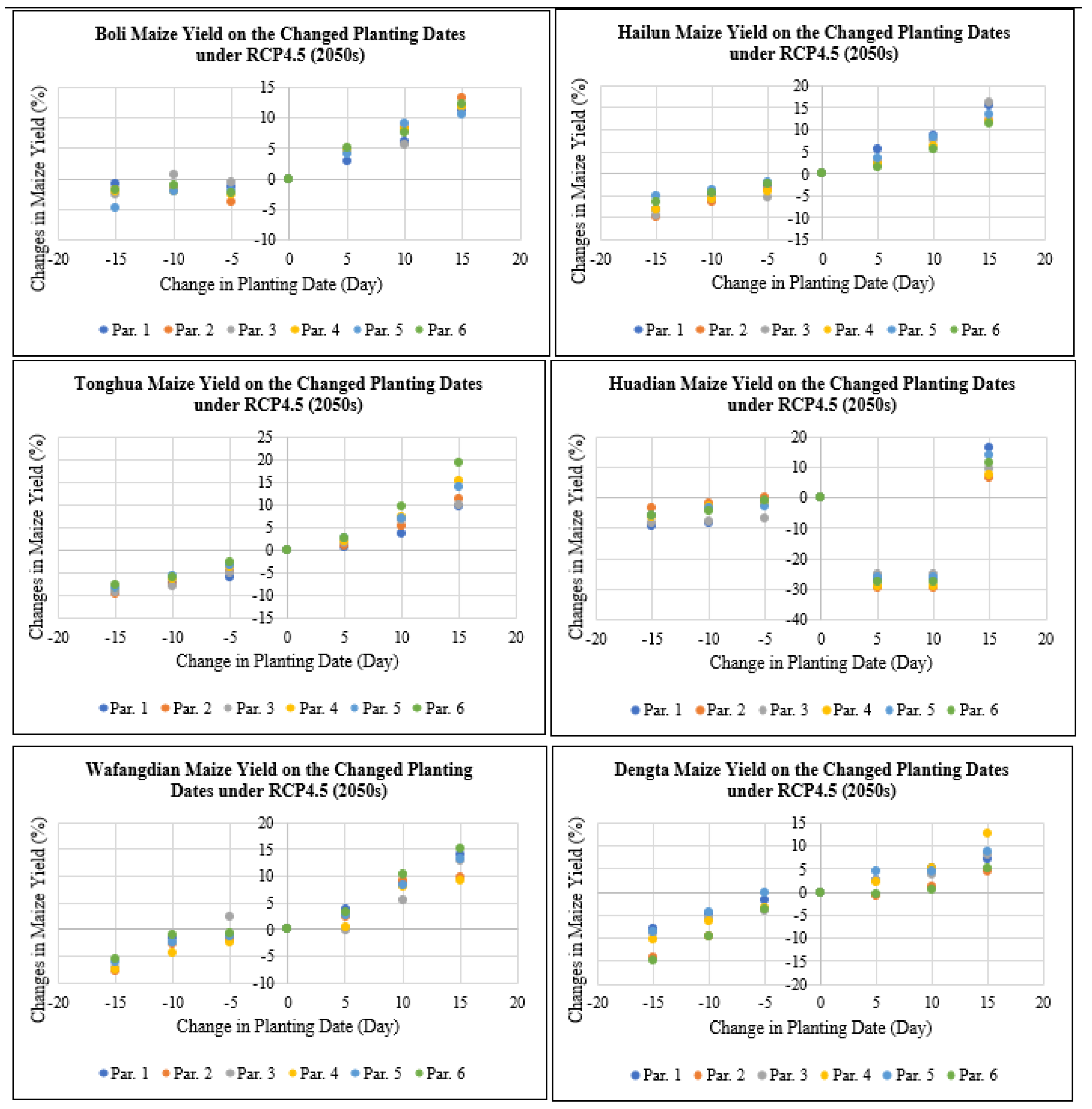

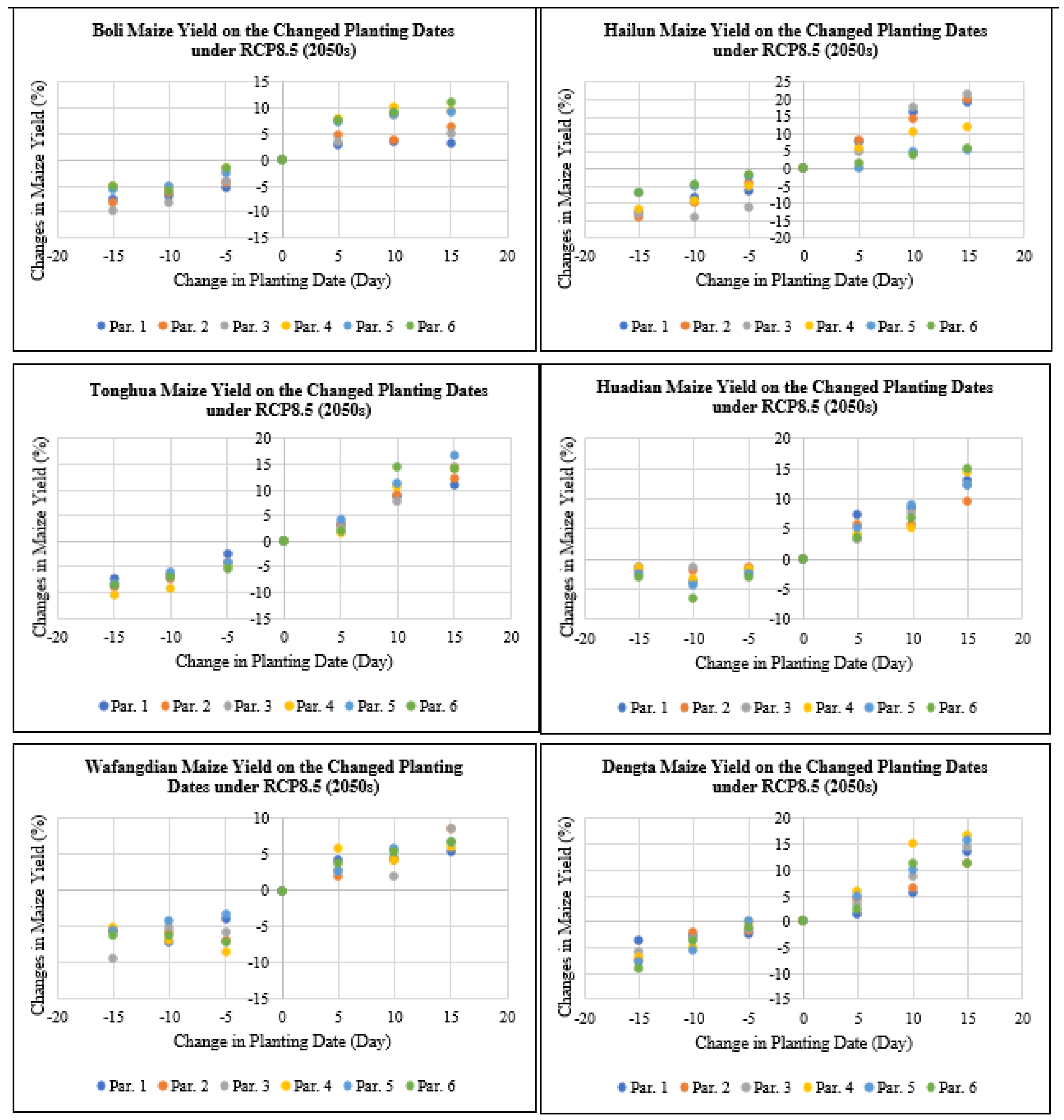

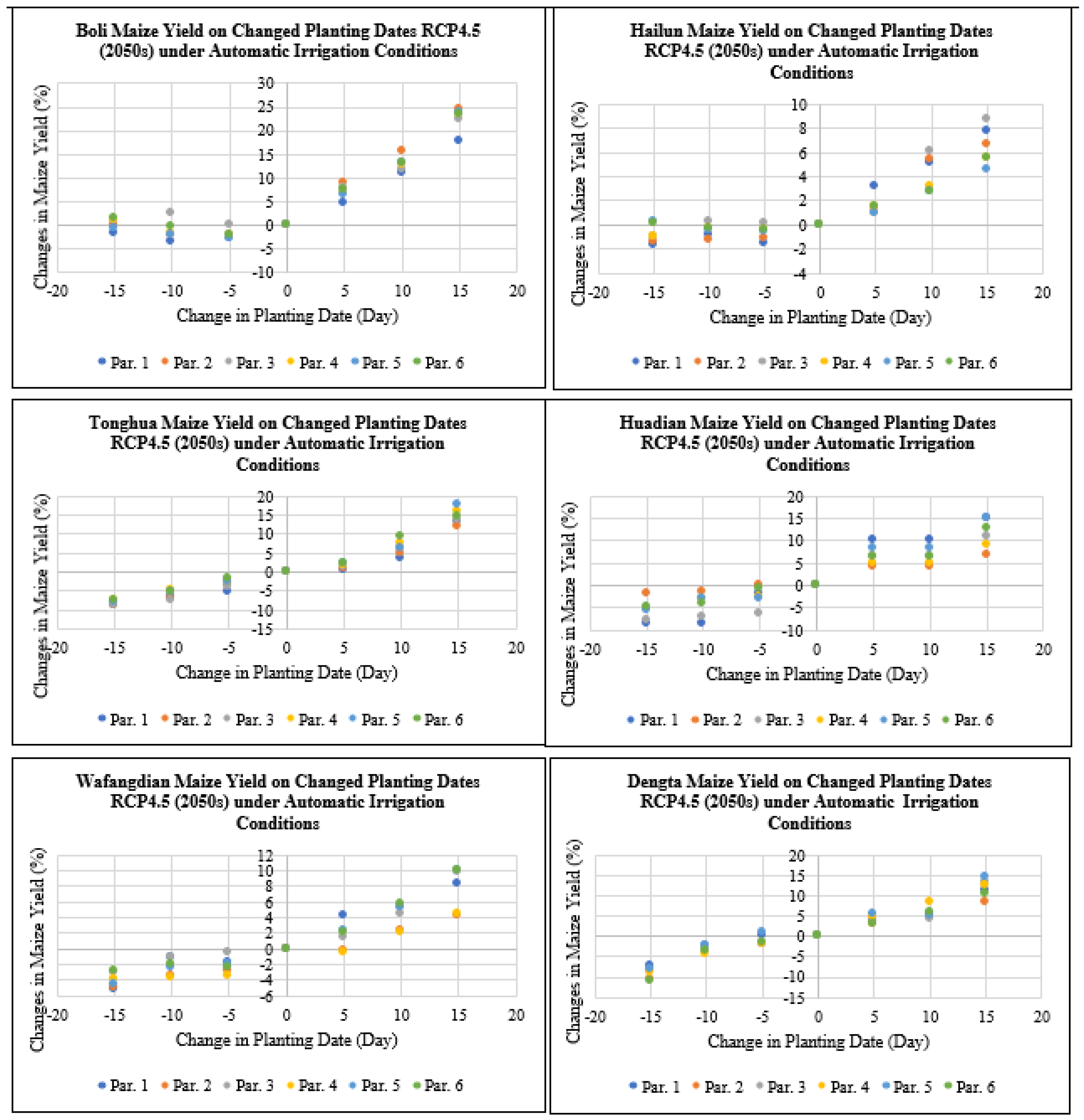

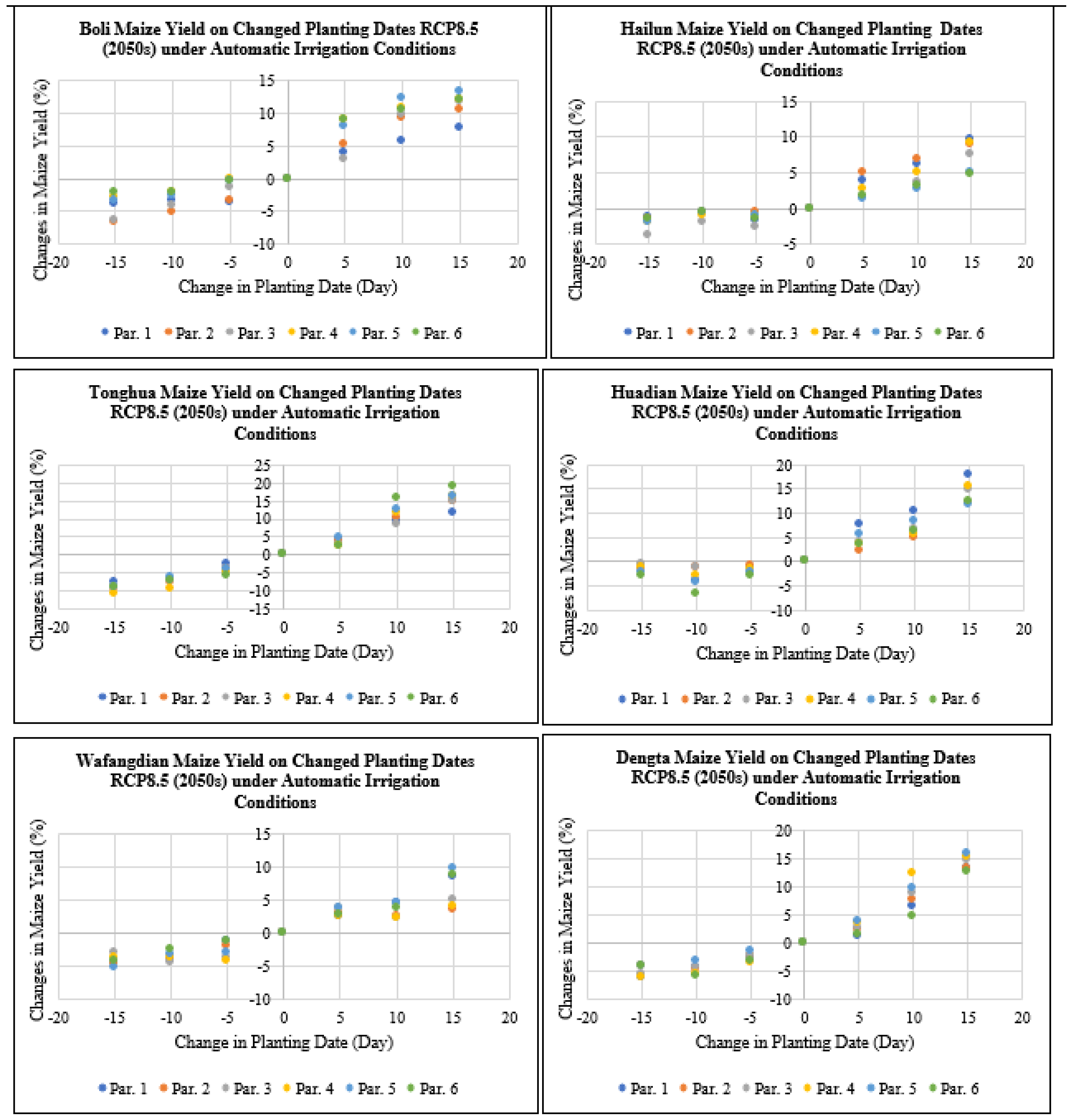
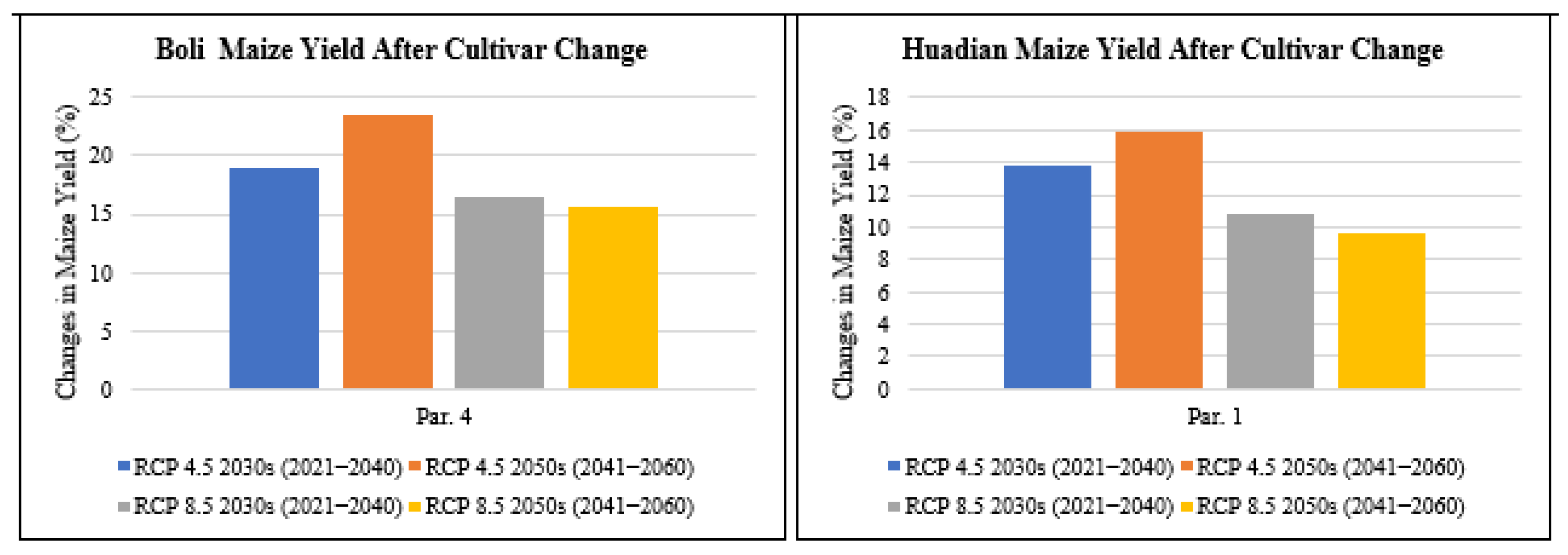

| Coefficient | Definition | Unit |
|---|---|---|
| P1 | Thermal time from seedling emergence to the end of the juvenile phase (above a base temperature of 8°C) during which the plant is not responsive to changes in photoperiod | °C days |
| P2 | Extent to which development is delayed for each hour increase in photoperiod above the longest photoperiod at which development proceeds at a maximum rate (which is considered to be 12.5 h). | days |
| P5 | Thermal time from silking to physiological maturity (expressed in degree days above a base temperature of 8°C). | °C days |
| G2 | Maximum possible number of kernels per plant. | Number |
| G3 | Kernel filling rate during the linear grain filling stage and under optimum conditions. | Mg day−1 |
| PHINT | Phyllochron interval: the interval in thermal time between successive leaf tip appearances | °C days |
| Province | Site | Latitude (N) | Longitude (E) | Altitude (m) | Maize Cultivar | Type of Maturity | Years |
|---|---|---|---|---|---|---|---|
| Heilongjiang | Boli | 45.45 | 130.35 | 220.5 | 4zao6 | Early | 2005, 2006 *, 2008 |
| Hailun | 47.26 | 126.58 | 239.2 | Haiyu 6 | Medium | 2005, 2006, 2007 * | |
| Jilin | Tonghua | 41.4 | 125.44 | 384.3 | Jidan 159 | Medium | 2006, 2008 *, 2009 |
| Huadian | 42.59 | 126.45 | 263.3 | Limin15 | Medium | 2006, 2007, 2008 * | |
| Liaoning | Wafangdian | 39.38 | 122.01 | 118.5 | Lianyu 6 | Late | 2006 *, 2007, 2008 |
| Dengta | 41.25 | 123.19 | 42 | Dongdan 60 | Late | 2006 *, 2007, 2008 |
| Province | Study Site | Mean Temperature (°C) | Precipitation (mm) (%) | Solar Radiation (MJ m−2 d−1) (%) | ||||
|---|---|---|---|---|---|---|---|---|
| Heilongjiang | Boli | Scenarios | 2030s | 2050s | 2030s | 2050s | 2030s | 2050s |
| RCP 4.5 | 0.18 | 1.30 | 24.68 | 21.20 | −8.72 | −8.54 | ||
| RCP 8.5 | 0.08 | 1.57 | 15.01 | 13.51 | −8.72 | −10.26 | ||
| Hailun | RCP 4.5 | 1.70 | 2.92 | 12.98 | −1.94 | −6.00 | −4.82 | |
| RCP 8.5 | 1.64 | 3.19 | 5.52 | 4.15 | −7.32 | −7.35 | ||
| Jilin | Tonghua | RCP 4.5 | −2.14 | −1.11 | 23.16 | 25.24 | −23.24 | −23.44 |
| RCP 8.5 | −2.21 | −0.85 | 12.55 | 22.73 | −24.58 | −24.43 | ||
| Huadian | RCP 4.5 | 2.56 | 3.64 | 6.60 | 2.11 | −9.89 | −10.05 | |
| RCP 8.5 | 2.39 | 3.85 | −6.06 | −0.07 | −11.78 | −11.28 | ||
| Liaoning | Wafangdian | RCP 4.5 | 1.78 | 2.87 | 8.65 | 15.76 | −16.15 | −15.51 |
| RCP 8.5 | 1.98 | 3.37 | 23.01 | 23.43 | −16.97 | −16.22 | ||
| Dengta | RCP 4.5 | 1.94 | 3.03 | 8.33 | 2.58 | −9.15 | −9.51 | |
| RCP 8.5 | 1.92 | 3.35 | −4.28 | −3.35 | −10.50 | −9.84 | ||
| Calculated Genetic Coefficients of Each Maize Cultivar | Time-to-Flowering | Time-to-Maturity | Maize Yield | |||||||||||
|---|---|---|---|---|---|---|---|---|---|---|---|---|---|---|
| Site | Parameter | Cultivar * | P1 | P2 | P5 | G2 | G3 | PHINT | NRMSE (%) | PD (%) | NRMSE (%) | PD (%) | NRMSE (%) | PD (%) |
| Boli | 1 | 4zao6 | 195 | 0.13 | 606 | 979 | 7.63 | 49 | 4.6 | 1.4 | 3.2 | 3.7 | 4.5 | 1.5 |
| Boli | 2 | 4zao6 | 172 | 0.50 | 655 | 978 | 7.09 | 49 | 2 | −1.4 | 2.8 | 1.5 | 1.6 | −4.2 |
| Boli | 3 | 4zao6 | 155 | 0.52 | 682 | 983 | 7.06 | 49 | 2.7 | 1.4 | 2.8 | 3.7 | 1 | −3.0 |
| Boli | 4 | 4zao6 | 165 | 0.52 | 648 | 980 | 7.20 | 49 | 2 | −1.4 | 3.2 | 1.5 | 1.5 | −1.3 |
| Boli | 5 | 4zao6 | 155 | 0.80 | 650 | 977 | 7.21 | 49 | 2 | −1.4 | 2.8 | 1.5 | 1.1 | −2.8 |
| Boli | 6 | 4zao6 | 165 | 0.56 | 642 | 975 | 7.45 | 49 | 2 | 1.4 | 3.2 | 3.7 | 6.5 | 1.3 |
| Hailun | 1 | Haiyu 6 | 217 | 0.30 | 656 | 983 | 15.60 | 49 | 2.6 | 5.1 | 2.5 | −2.8 | 3.9 | 5.3 |
| Hailun | 2 | Haiyu 6 | 222 | 0.12 | 631 | 924 | 16.48 | 49 | 2.6 | 5.1 | 2.5 | −2.8 | 4.1 | 6.1 |
| Hailun | 3 | Haiyu 6 | 158 | 1.15 | 601 | 840 | 15.77 | 49 | 4.9 | 2.5 | 3.5 | −3.5 | 2.1 | 8.8 |
| Hailun | 4 | Haiyu 6 | 203 | 0.46 | 749 | 951 | 16.35 | 49 | 2.6 | 5.1 | 2.5 | −2.8 | 3.7 | 6.8 |
| Hailun | 5 | Haiyu 6 | 163 | 1.40 | 925 | 971 | 16.12 | 49 | 2.6 | 5.1 | 2.5 | −3.5 | 3.3 | 6.9 |
| Hailun | 6 | Haiyu 6 | 197 | 0.64 | 920 | 964 | 16.21 | 49 | 2.6 | 5.1 | 2.5 | −3.5 | 3.3 | 7.2 |
| Tonghua | 1 | Jidan 159 | 301 | 0.24 | 676 | 827 | 8.676 | 49 | 0.8 | 0.0 | 0.5 | −2.1 | 5.8 | 0.1 |
| Tonghua | 2 | Jidan 159 | 281 | 0.69 | 698 | 574 | 11.46 | 49 | 0.8 | 0.0 | 2.1 | −0.7 | 5.8 | 0.2 |
| Tonghua | 3 | Jidan 159 | 293 | 0.52 | 685 | 746 | 9.282 | 49 | 0.8 | 0.0 | 1.1 | −1.4 | 7.7 | 0.1 |
| Tonghua | 4 | Jidan 159 | 259 | 1.15 | 680 | 701 | 9.938 | 49 | 0.8 | 0.0 | 0.7 | −2.1 | 6.9 | 1.4 |
| Tonghua | 5 | Jidan 159 | 267 | 0.86 | 686 | 652 | 10.5 | 49 | 0.8 | 0.0 | 1.1 | −1.4 | 5.8 | 0.1 |
| Tonghua | 6 | Jidan 159 | 232 | 1.73 | 690 | 814 | 8.425 | 49 | 0.8 | 0.0 | 1.4 | −1.4 | 6.8 | 1.5 |
| Huadian | 1 | Limin15 | 186 | 1.61 | 581 | 970 | 8.75 | 49 | 1.1 | −1.1 | 3.8 | 5.0 | 6.9 | 1.8 |
| Huadian | 2 | Limin15 | 228 | 0.20 | 590 | 975 | 9.454 | 49 | 2.5 | −3.4 | 2 | 0 | 7 | 2.1 |
| Huadian | 3 | Limin15 | 172 | 1.59 | 584 | 945 | 9.915 | 49 | 2.5 | −3.4 | 2 | 0 | 7.1 | 1.3 |
| Huadian | 4 | Limin15 | 217 | 0.58 | 604 | 934 | 9.242 | 49 | 2.5 | −3.4 | 2 | 0 | 7.1 | 1.3 |
| Huadian | 5 | Limin15 | 176 | 1.76 | 597 | 949 | 9.345 | 49 | 2.5 | −3.4 | 2 | 0 | 7.1 | 1.5 |
| Huadian | 6 | Limin15 | 197 | 1.22 | 599 | 945 | 9.413 | 49 | 2.5 | −3.4 | 2 | 0 | 7.1 | 1.6 |
| Wafangdian | 1 | Lianyu 6 | 296 | 1.21 | 740 | 708 | 11.64 | 49 | 1.7 | 2.3 | 2.6 | −0.7 | 4.9 | −1.0 |
| Wafangdian | 2 | Lianyu 6 | 296 | 1.42 | 679 | 978 | 14.99 | 49 | 1.7 | 2.3 | 2.1 | −5.0 | 10.8 | −7.5 |
| Wafangdian | 3 | Lianyu 6 | 293 | 1 | 736 | 818 | 8.928 | 49 | 2.3 | 0.0 | 1.1 | −3.5 | 8.5 | −5.1 |
| Wafangdian | 4 | Lianyu 6 | 308 | 1.12 | 707 | 935 | 15.72 | 49 | 1.7 | 2.3 | 1.1 | −3.5 | 8 | −4.6 |
| Wafangdian | 5 | Lianyu 6 | 296 | 1.19 | 715 | 490 | 16.23 | 49 | 1.7 | 2.3 | 1.1 | −2.8 | 6.7 | −3.8 |
| Wafangdian | 6 | Lianyu 6 | 280 | 1.53 | 727 | 584 | 13.87 | 49 | 1.7 | 2.3 | 1.5 | −2.1 | 5.4 | −1.5 |
| Dengta | 1 | Dd60 | 310 | 0.77 | 761 | 460 | 16.09 | 49 | 1.6 | 3.6 | 2 | −2.1 | 10 | 8.6 |
| Dengta | 2 | Dd60 | 322 | 0.18 | 779 | 962 | 8.295 | 49 | 1.6 | 2.4 | 2 | −2.8 | 7.3 | 6.6 |
| Dengta | 3 | Dd60 | 311 | 0.65 | 780 | 482 | 14.25 | 49 | 1.6 | 3.6 | 1.1 | 0 | 9.9 | 7.5 |
| Dengta | 4 | Dd60 | 291 | 1.07 | 779 | 415 | 16.28 | 49 | 2.2 | 2.4 | 0.5 | −2.8 | 9.6 | 3.4 |
| Dengta | 5 | Dd60 | 295 | 1.01 | 787 | 437 | 15.56 | 49 | 2.8 | 3.6 | 0.5 | 1.4 | 9.9 | 7.8 |
| Dengta | 6 | Dd60 | 323 | 0.09 | 814 | 958 | 7.33 | 49 | 1.6 | 2.4 | 2 | 1.4 | 6.5 | 4.9 |
Publisher’s Note: MDPI stays neutral with regard to jurisdictional claims in published maps and institutional affiliations. |
© 2022 by the authors. Licensee MDPI, Basel, Switzerland. This article is an open access article distributed under the terms and conditions of the Creative Commons Attribution (CC BY) license (https://creativecommons.org/licenses/by/4.0/).
Share and Cite
Koimbori, J.K.; Wang, S.; Pan, J.; Guo, L.; Li, K. Yield Response of Spring Maize under Future Climate and the Effects of Adaptation Measures in Northeast China. Plants 2022, 11, 1634. https://doi.org/10.3390/plants11131634
Koimbori JK, Wang S, Pan J, Guo L, Li K. Yield Response of Spring Maize under Future Climate and the Effects of Adaptation Measures in Northeast China. Plants. 2022; 11(13):1634. https://doi.org/10.3390/plants11131634
Chicago/Turabian StyleKoimbori, Jackson K., Shuai Wang, Jie Pan, Liping Guo, and Kuo Li. 2022. "Yield Response of Spring Maize under Future Climate and the Effects of Adaptation Measures in Northeast China" Plants 11, no. 13: 1634. https://doi.org/10.3390/plants11131634
APA StyleKoimbori, J. K., Wang, S., Pan, J., Guo, L., & Li, K. (2022). Yield Response of Spring Maize under Future Climate and the Effects of Adaptation Measures in Northeast China. Plants, 11(13), 1634. https://doi.org/10.3390/plants11131634









